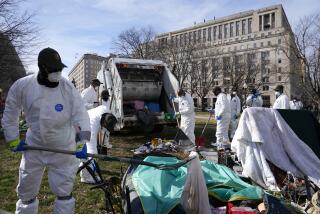Pennsylvania Avenue Plaza Opens
- Share via
WASHINGTON — In the chill of a November day, a crowd gathered for one of the most routine rituals of civic improvement, the ceremonial opening of a pedestrian mall.
But in this case, the refurbished plaza dedicated Tuesday used to be part of Pennsylvania Avenue -- the route envisioned by Thomas Jefferson as the city’s grand boulevard, symbolizing an accessible democracy.
In the nation’s capital, fears of terrorism continue to reshape the landscape in ways small and large. The conversion of this small stretch of “America’s Main Street” in front of the White House -- from a major traffic thoroughfare into a pedestrian plaza -- is one of the more modest, in scale if not in symbolism.
More ambitious are efforts to reroute major freight traffic around the capital so that terrorists cannot target chemical or toxic cargo. The City Council decided Tuesday not to prohibit such cargo from entering the city, but security officials made clear that comprehensive plans including dealing with such threats are being drafted.
During the pedestrian plaza ceremony, Mayor Anthony Williams pointed out the dichotomy. “The challenge of Pennsylvania Avenue,” he said, “is symbolic of the ongoing struggle of our efforts to better balance national homeland security needs in a dangerous world ... with real freedom for our citizens.”
The area in front of the White House was closed to vehicles after the 1995 bombing of the federal building in Oklahoma City; the blockade was expanded after the Sept. 11 attacks.
What was once a bustling artery became little more than a hub for flowerpot blockades, steel barriers and idle police cars -- anything but a welcome sight for visitors, not to mention the occupants of the White House, whose front windows overlook the street.
City officials urged that the street be reopened to traffic; federal officials raised fears. They decided on a compromise: a $29-million pedestrian mall.
Designed by landscape architect Michael Van Valkenburgh, the pathway is divided into three sections. The two entry points are paved with gray granite and the center -- directly across from the White House -- is lined with light-brown crushed rock. Street lamps dot the sidewalk where elm trees and granite benches will soon be placed.
Security is still heavy; four guard booths line the entry points of the plaza. Two rows of fluted posts provide an additional barrier to vehicles.
After a rushed 10-month construction period, the plaza opened with plenty of time to set up for January’s presidential inaugural parade, which traditionally passes in front of the White House.
City officials continue to debate how best to handle terrorist threats.
At Tuesday’s City Council meeting, members considered barring freight trains carrying hazardous material from passing through the city boundaries. If approved, it would have been the first such decision in the nation.
About 8,000 shipments of hazardous material pass through the District of Columbia annually, according to CSX, the major freight company sending trains through the area. The measure called on the railroads to reroute toxic inhalants, such as chlorine and ammonia, which account for about 1,000 of the shipments.
Some council members chastised the Department of Homeland Security for failing to look into rerouting such cargo. But with reports that railroad companies, on their own, were already beginning to reroute shipments, the council members’ debate hung on whether they needed a city rule to ensure that the federal government followed through or should simply allow companies to figure out the safest passage for such materials.
The council chose the latter -- fearful, in the words of council member Carol Schwartz, that passing legislation might “open a Pandora’s box” for railroads across the country by encouraging other cities to do the same.
But if the legislation’s sponsor, council member Kathleen Patterson has any say, Tuesday’s decision won’t be the last word. She plans to reintroduce the bill again in two weeks.
More to Read
Sign up for Essential California
The most important California stories and recommendations in your inbox every morning.
You may occasionally receive promotional content from the Los Angeles Times.













